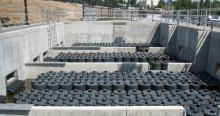Key takeaways
When Sea-Tac Airport opened its controversial third runway in 2008, it also began a new chapter in Puget Sound stormwater regulations. Citizens and state regulators had raised concerns about how the runway might affect three nearby creeks flowing into Puget Sound, and the state Department of Ecology issued its most stringent industrial stormwater permit to date.
The airport posed a special challenge—a near “perfect storm” for stormwater—combining large amounts of impervious surfaces like runways with the heavy use of toxic chemicals ranging from jet fuel to deicer. Every inch of rain that falls at Sea-Tac generates “about 6 million gallons worth of wastewater that we have to deal with,” says Elizabeth Leavitt, the airport’s Director of Aviation Planning and Environmental Services. Leavitt spoke at the 2014 Salish Sea Ecosystem Conference as part of a special session on “Integrating economic growth with ecological protection and restoration of the Salish Sea.”
SEA: #15 in U.S.
More than 34 million passengers board several hundred thousand flights at Sea-Tac each year, making it among the nation’s 15 busiest airports.
At the session, Leavitt described how Sea-Tac is working to meet special controls on the toxicity of its stormwater, including strict limits on the amounts of heavy metals and other pollutants. But while the airport might be seen as an outlier with a unique set of challenges, it could also hold increasing relevance for the future of everyday stormwater management.

Extreme stormwater
Based on its permit, the airport provides an example of what might be called extreme stormwater. Sea-Tac is “ahead of where other typical stormwater requirements are in the region,” says Jerry Shervey, Industrial Unit Supervisor at the Department of Ecology. It requires special cleaning facilities and intense monitoring. The entire airport has been retrofitted to contain the pollutants that could otherwise wash into the surrounding environment. But, according to Leavitt, there is one surprise.
Even as 34 million passengers board several hundred thousand flights per year at Sea-Tac, the place with the nastiest pollution is a familar but unexpected culprit—the road into the airport. “Most people would think that the runways are the most contaminated place at the airport,” Leavitt said at the conference. “It’s actually not the runways, [but] the expressways that bring all the cars and trucks through.”
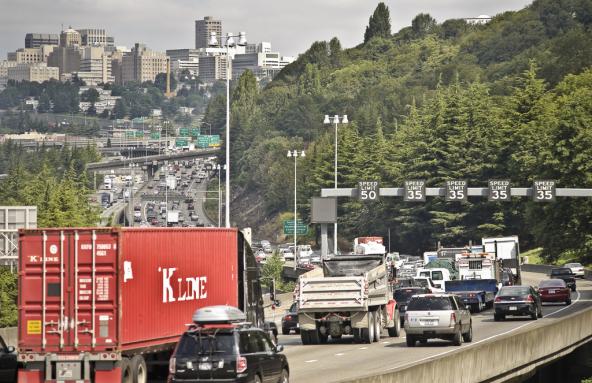
In that sense, industrial sites like the airport may not be the only places in Puget Sound with extreme stormwater. Hundreds of miles of highways in the region might be just as polluted.
Recent studies by NOAA bear this out. They point to stormwater runoff from highways as a likely suspect in the deaths of migrating salmon near stormwater outfalls. Known as “pre-spawn mortality,” the problem is so severe that scientists worry that it could lead to the extinction of several runs of Coho salmon within decades. [Read more about toxics in Salish Sea Currents].
Compared to the controlled environment at the airport, highways—and more broadly other municipal areas like towns and cities—are relatively open systems. Despite extensive stormwater treatment programs and regular monitoring, they all still face “potentially hundreds of outfalls and many thousands of potential inputs [of contaminants],” says Rachel McCrae, a municipal stormwater specialist at the Department of Ecology. From highway runoff to copper in moss killer, to PCBs in paint, and thousands of other contaminants, everyday stormwater is now viewed as one of the greatest threats to Puget Sound.
An evolving trend
This growing awareness of the region’s stormwater problem continues to prompt discussion of stricter controls. Although its efforts are still pending, the EPA has been working to update federal stormwater standards to include broader water quality limits. Other potential drivers include Washington’s proposed new fish consumption rates. Stormwater is identified as a chief source of toxic contaminants in fish, and this month the governor’s office and the Department of Ecology proposed new, stricter standards for surface water quality. These “drive pollution discharge limits for industries and other entities that discharge pollution,” reads an announcement from the department.
The degree to which stormwater regulations might change in the near future is still an open question. But even if city streets aren’t crowded with airplanes, tighter regulations may be taking off.
Read about some of the ways that Sea-Tac Airport deals with its stormwater below.
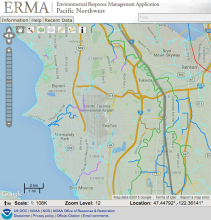 * The airport’s stormwater challenge is made greater by the presence of three salmon-bearing creeks that drain away from the airport, each eventually flowing into Puget Sound. These include the Miller-Walker creek system, Des Moines Creek and a small portion of Gilliam Creek (view the map to the right). “You can see while [Sea-Tac is] not the part of the port that sits right on the Puget Sound, we definitely have our impacts,” says Elizabeth Leavitt.
* The airport’s stormwater challenge is made greater by the presence of three salmon-bearing creeks that drain away from the airport, each eventually flowing into Puget Sound. These include the Miller-Walker creek system, Des Moines Creek and a small portion of Gilliam Creek (view the map to the right). “You can see while [Sea-Tac is] not the part of the port that sits right on the Puget Sound, we definitely have our impacts,” says Elizabeth Leavitt.
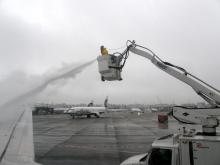 * Among the things setting the airport permit apart are so-called “effluent limits.” There are currently about 1100 active industrial stormwater permits in Washington, but most of these are guided by what are known as benchmarks. If exceeded, benchmarks require a series of corrective actions but do not necessarily trigger fines.
* Among the things setting the airport permit apart are so-called “effluent limits.” There are currently about 1100 active industrial stormwater permits in Washington, but most of these are guided by what are known as benchmarks. If exceeded, benchmarks require a series of corrective actions but do not necessarily trigger fines.
That’s not the case for the airport, which faces both fines and potential lawsuits if it exceeds the limits specified in its permit. This was tested early on during the runway’s construction phase, when the airport was fined a total of $145,000 for a number of stormwater-related discharges into nearby creeks.
 * The airport has its share of unique challenges. Stormwater treatment methods like catchment ponds have to balance environmental protection with federal safety regulations designed to avoid airplane bird strikes. Nets discourage birds from flocking to the area.
* The airport has its share of unique challenges. Stormwater treatment methods like catchment ponds have to balance environmental protection with federal safety regulations designed to avoid airplane bird strikes. Nets discourage birds from flocking to the area.
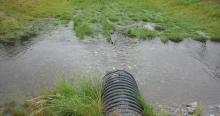
* Oyster shells are used to remove copper and zinc from stormwater.
 * Light rail and even proposed bicycle paths may also decrease toxics at the airport. “Most people would think that the runways are the most contaminated place at the airport. It’s actually not the runways, [but] the expressways that bring all the cars and trucks through.” —Elizabeth Leavitt
* Light rail and even proposed bicycle paths may also decrease toxics at the airport. “Most people would think that the runways are the most contaminated place at the airport. It’s actually not the runways, [but] the expressways that bring all the cars and trucks through.” —Elizabeth Leavitt
Learn more
Where is Sea-Tac Airport?
Seattle-Tacoma International Airport is located in the city of SeaTac, WA.
